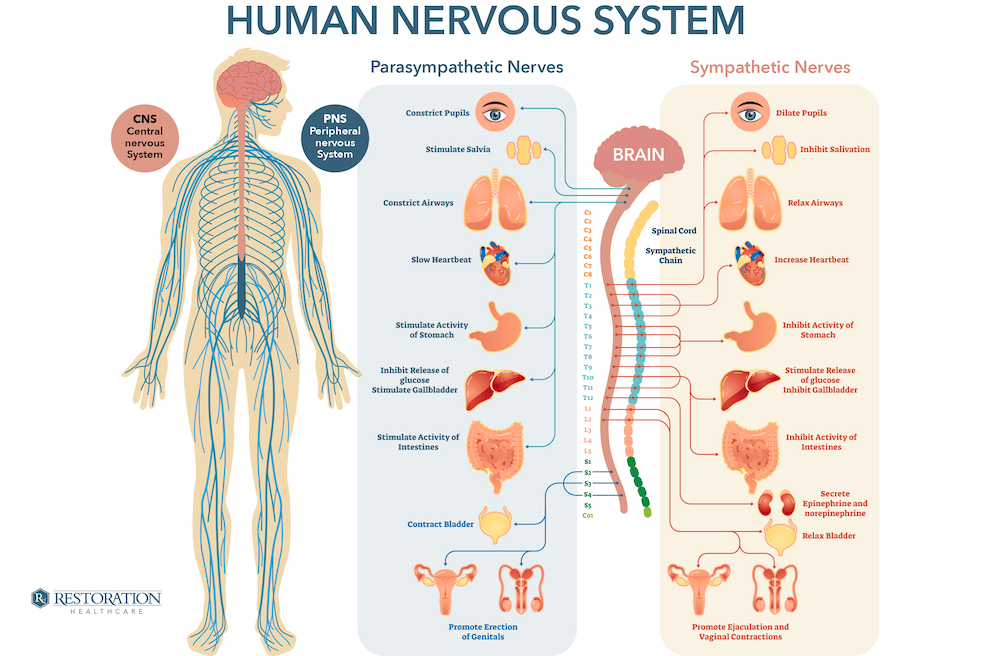Bringing Your Autonomic Nervous System in for a Checkup

If you’re about to visit our clinic for an ANS test, this blog post is for you. Autonomic nervous system (ANS) testing is one of the many diagnostics we perform at Restoration Healthcare to create and monitor your plan of care. Specifically, the test itself — which we may repeat every four to six months or so — is a highly accurate measurement of the body’s ability to regulate the two branches of the autonomic nervous system… the somatic nervous system (SNS) and the autonomic nervous system (ANS).
Since that’s a lot to take in, here’s an example of why this matters:
If you drive a car manufactured in the 1980s or more recently, it has a device called an electronic control unit (ECU) that functions as the car’s brain. Sensors on the engine and along the exhaust system send data back to the ECU, which interprets that information in order to make the necessary adjustments that keep the engine running as efficiently as possible. If your car is running rough, or the Check Engine light comes on indicating an issue you may not otherwise have noticed, your mechanic connects a diagnostic device to the ECU, which reads error codes that the mechanic can use to diagnose the problem and make the repair.
Your brain is your body’s ECU. It controls and monitors everything going on in your body to ensure that all systems are functioning properly and working well as a whole. It controls everything from your heartbeat and breathing to your blood pressure and body temperature, along with every conscious and unconscious move you make. Your brain sends and receives signals from other parts of your body through an intricate communications network of nerve cells. The control center is the central nervous system (CNS), consisting of the brain and spinal column. Other nerves branch out from the spinal column to different parts of the body — collectively, these nerves are referred to as the peripheral nervous system.
The CNS can be divided into two parts — the SNS (somatic nervous system) and the ANS (autonomic nervous system).
- The SNS has sensory and motor pathways the control muscles and movement.
- The ANS has only motor pathways, which control bodily functions not consciously directed, such as breathing, heartbeat, digestion, metabolism, body temperature, and the fight-or-flight response.
Obviously, any ANS dysfunction will negatively impact other systems in the body, but certain dysfunctions in other systems can negatively impact the ANS, as well — conditions such as diabetes, Parkinson’s disease, autoimmunity, and chronic stress.
The Sympathetic and Parasympathetic Nervous System
The ANS consists of two branches (subsystems) — with one that generally acts as the accelerator and the other as the brake:
- Sympathetic autonomic nervous system (SANS) acts as the accelerator, controlling your body’s response to stressful situations (fight or flight). It is always active to a certain degree, but activity elevates significantly in stressful situations by upregulating hormone release.
- Parasympathetic autonomous nervous system (PANS) functions as the brake, controlling your body’s response to relaxation, recovery, digestion, and sexual response. It is continuously active to a certain degree, but activity increases shortly after eating and around bedtime. PANS slows the heart rate, dilates (expands) blood vessels, controls muscle movement, and influences memory.
Ideally, the two branches of the ANS accelerate and decelerate other systems in the body to maintain a healthy balance. Imbalances between the two branches impair the body’s regulatory and restorative capabilities.
Short-term effects of an imbalance include the following:
- High levels of cortisol result in cell damage and inflammation.
- Tissue and cell growth are negatively impacted.
- Hormone disruption/imbalance occurs, possibly impacting sex hormones, thyroid, and metabolism.
- The liver’s ability to detox is impaired, adding to the body’s toxic burden.
- Digestion is impaired, contributing to nutrient deficiencies and imbalances.
- Neurotransmitters are not released as they should be, adding to anxiety, depression, difficulty sleeping, and more.
Symptoms of Automatic Nervous System Dysfunction
Over time, autonomic nervous system dysfunction can develop into chronic conditions with one or more of the following symptoms:
- Chronic fatigue
- Chronic pain, such as fibromyalgia
- Difficulty falling asleep or staying asleep
- Difficulty urinating, incontinence, or incomplete emptying of the bladder
- Difficulty with memory and brain function in the morning
- Dizziness and fainting upon standing
- Erectile dysfunction, vaginal dryness, or difficulty having an orgasm
- Exercise intolerance
- Gastrointestinal/digestive dysfunction (acid reflux, constipation, diarrhea)
- Hormonal/menopause-like symptoms, especially ages 35–45
- Inability to alter heart rate with exercise
- Loss of appetite or difficulty swallowing
- Mood irregularities such as depression, anxiety, panic attacks
- Morning migraines or headaches
- Muscle weakness or tremors
- Sweating too much or not enough
- Vision problems, including blurry vision, inability to respond to changes in light
However, even before symptoms become noticeable, ANS dysfunction can exist, just as your car may seem to be running well even though the Check Engine light appears, indicating a problem.
What Is ANS Testing?
As we said at the outset of this post, ANS testing takes a measurement of your body’s ability to regulate the SANS and PANS. Specifically, the test — which is be billed to your health insurance company with a minimal out-of-pocket charge — takes readings using two pulsometers to measure heart rate, two blood pressure cuffs to measure blood pressure at the upper and lower extremities, and three electrocardiogram (ECG or EKG) leads to monitor the electrical activity of the heart.
Results of the ANS testing show how well your ANS regulates your heartbeat, blood pressure, and stress response. Results may also point to possible problems with the heart, such as parts of the heart that are too large or are overworked, and blockages in blood vessels.
Why We Test ANS Function
ANS testing is a valuable diagnostic tool that helps us dig down to the root cause of a variety of illnesses and dysfunctions. We conduct ANS testing in our clinic primarily for three reasons:
- To determine whether you have an illness or dysfunction that attacks the autonomic nervous system. Certain chronic conditions, including diabetes, Parkinson’s disease, autoimmunity, and chronic stress, can damage the nerves of the ANS.
- To detect early warning signs of ANS impairment even before symptoms become noticeable, so we can identify and address issues before they cause more damage.
- To find out why someone is not responding as well as expected to treatments for other conditions and to guide treatment recommendations moving forward.
Find Out More About ANS Testing at Restoration Healthcare
To learn more about the autonomic nervous system and ANS testing, including what you can expect during the testing procedure, ask your Restoration Healthcare physician, physician assistant, or medical assistant for a copy of our guide, Understanding Autonomic Nervous System Testing — A Restoration Healthcare guide to understanding the autonomic nervous system (ANS) and ANS testing.
– – – – – – – – –
Disclaimer: The information in this blog post about autonomic nervous system (ANS) and ANS testing, is provided for general informational purposes only and may not reflect current medical thinking or practices. No information contained in this post should be construed as medical advice from the medical staff at Restoration Healthcare, Inc., nor is this post intended to be a substitute for medical counsel on any subject matter. No reader of this post should act or refrain from acting on the basis of any information included in, or accessible through, this post without seeking the appropriate medical advice on the particular facts and circumstances at issue from a licensed medical professional in the recipient’s state, country or other appropriate licensing jurisdiction.



